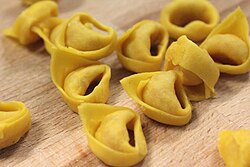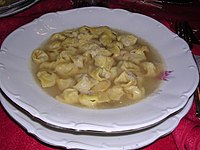Tortellini
You can help expand this article with text translated from the corresponding article in Italian. (June 2024) Click [show] for important translation instructions.
|
 The distinctive shape of tortellini | |
| Type | Pasta |
|---|---|
| Place of origin | Italy |
| Region or state | Emilia-Romagna |
| Variations | Tortelloni |
Tortellini is a type of stuffed pasta typical of the Italian cities of Bologna and Modena. Traditionally it is stuffed with a mix of meat (pork loin, raw prosciutto, mortadella), Parmesan cheese, egg and nutmeg and served in capon broth (in brodo di cappone).[1]
In the area of origin it is usually sold fresh or home-made. Industrially packaged, dried, refrigerated, or frozen tortellini appear in many locations around the world, especially where there are large Italian communities.
Origins
The origin of tortellini is disputed; both Bologna and Modena, cities in Italy's Emilia-Romagna region, claim to be its birthplace.[2] The etymology of tortellini is the diminutive form of tortello, itself a diminutive of torta (lit. 'cake' or 'pie').[3]
The recipe for a dish called tortelletti appears in 1570 from Bartolomeo Scappi. Vincenzo Tanara's writings in the mid-17th century may be responsible for the pasta's renaming to tortellini. In the 1800s, legends sprang up to explain the recipe's origins, offering a compromise. Castelfranco Emilia, located between Bologna and Modena,[2] is featured in one legend, in which Venus stays at an inn. Overcome by her beauty, the innkeeper spies on her through a keyhole, through which he can only see her navel. He is inspired to create a pasta in this shape. This legend would be at the origin of the term ombelico di Venere (lit. 'Venus' navel'), occasionally used to describe tortellini.[4] In honour of this legend, an annual festival is held in Castelfranco Emilia.[5] Another legend posits that the shape comes from Modena's architecture, which resembles a turtle.[6]
-
Tortellini in brodo
-
Industrially-made tortellini, easily recognizable for the extremely regular cut of the dough and the symmetrical closing of the extremities
Comparison with tortelloni
Tortelloni is pasta in a similar shape, but larger, typically 5 g, vs. 2 g for tortellini.[7] While tortellini has a meat-based filling, tortelloni is filled with ricotta and sometimes with parsley or spinach. Moreover, while tortellini is traditionally cooked in and served with broth, tortelloni is cooked in water, stir-fried (traditionally with butter and sage) and served dry.
National Tortellini Day
National Tortellini Day is celebrated annually on February 13.
See also
References
- ^ "Official recipe of the tortellino, as it was registered at the Chamber of Commerce of Bologna in 1974" (PDF). www.confraternitadeltortellino.it (in Italian). Retrieved 2018-12-31.
- ^ a b Zanini De Vita, Oretta (2009). Encyclopedia of Pasta. University of California Press. pp. 297–299. ISBN 9780520944718.
- ^ "The meaning of pasta names". OxfordDictionaries.com. Archived from the original on December 1, 2017. Retrieved 12 May 2018.
- ^ The Oxford Companion to Italian Food by Gillian Riley
- ^ Poggioli, Sylvia (27 August 2013). "Tortellini, the Dumpling Inspired By Venus' Navel". Morning Edition. NPR. Retrieved 12 May 2018.
- ^ Marsden, Shelley (4 December 2015). "The secret to tortellini, Modena's special pasta". The Daily Telegraph. Archived from the original on 13 May 2018. Retrieved 12 May 2018.
- ^ Barilla US (manufacturer) FAQ
External links
- Hand-made tortellini original recipe by a cooking school located in Bologna Archived 2015-12-23 at the Wayback Machine
- Hand-made tortellini in brodo how-to, with video
- Tortellini production video
- From the rolled out egg-rich and flour pasta dough, stuffed with a mix of meat, the hand made production of tortellini (navel-shaped pasta) - video


